Counts of Schauenburg and Holstein
The Counts of Schauenburg and Holstein were titles of the Frankish Empire. The dynastic family came from the County of Schauenburg near Rinteln (district Schaumburg) on the Weser in Germany. Together with its ancestral possessions in Bückeburg and Stadthagen, the House of Schauenburg ruled the County of Schauenburg and the County of Holstein. The comital titles of Holstein were subject to the liege lord, the Dukes of undivided Saxony till 1296, and thereafter the Dukes of Saxe-Lauenburg.

The counties of Schauenburg and Holstein
The County of Schaumburg originated as a medieval county, which was founded at the beginning of the 12th century. It was named after Schauenburg Castle, near Rinteln on the Weser, where the owners started calling themselves Lords (from 1295 Counts) of Schauenburg. Adolf I probably became the first Lord of Schauenburg in 1106. In 1110, Adolf I, Lord of Schauenburg was appointed by Lothair, Duke of Saxony to hold Holstein and Stormarn, including Hamburg, as fiefs.[1]
In a battle with Denmark, however, Adolf III became prisoner of the king Valdemar II, to whom he had to give Holstein in exchange for his freedom. In 1227 Adolf III's son, Adolf IV, recovered the lost lands from Denmark. Subsequently, the House of Schaumburg were also counts of Holstein and its partitions Holstein-Itzehoe, Holstein-Kiel, Holstein-Pinneberg (till 1640), Holstein-Plön, Holstein-Segeberg and Holstein-Rendsburg (till 1460) and through the latter at times also the dukes of Schleswig.
Holstein partitions of 1261 and 1273
After 1261 the previously jointly ruling brothers Gerhard I and the elder John I divided the Counties of Holstein and Schauenburg (Schaumburg). Gerhard I received the Counties of Holstein-Itzehoe and Schaumburg, whereas John received the County of Holstein-Kiel. After the death of John I, his sons Adolphus V and John II reigned jointly in Holstein-Kiel. In 1273 they partitioned Holstein-Kiel and John II continued ruling over Kiel; Adolphus V the Pomeranian then received Segeberg (aka County of Stormarn). After the death of Adolphus V, Holstein-Segeberg was reincorporated into Holstein-Kiel.
Holstein partition of 1290 and reversions of 1350 and 1390
After Gerhard I's death in 1290 his three younger sons partitioned Holstein-Itzehoe and Schaumburg into three branches, with Adolph VI the Elder, the third brother, getting Holstein-Pinneberg and Schaumburg south of the Elbe, the second brother Gerhard II the Blind getting Holstein-Plön, and the fourth Henry I receiving Holstein-Rendsburg. The eldest brother John was Canon at the Hamburg Cathedral.
After the death of Gerhard II his sons Gerhard IV and his younger half-brother John III the Mild inherited and ruled in Holstein-Plön together. In 1316 the brothers militarily seized the possessions of John II the One-Eyed (d. 1321) in Holstein-Kiel, whose sons had been killed. John III the Mild, before a second-born co-ruling count in Plön, then received Kiel from the deposed John II the One-Eyed, a cousin of his father Gerhard II the Blind. Gerhard IV continued ruling Holstein-Plön as sole count.
After the death of John III's nephew Gerhard V, Count of Holstein-Plön in 1350, who had succeeded Gerhard IV, the Plön line became extinct and John III re-inherited their possessions. In 1390 his son Adolphus IX (aka VII)[2] ruling since 1359 Kiel including Plön, died without issue and thus Nicholas (Claus) of Holstein-Rendsburg and his nephews Albert II and Gerhard VI (jointly ruling till 1397) succeeded to the territories of Holstein-Kiel and Holstein-Plön.
Holstein partition of 1397 and the extinction of the Rendsburg line in 1459
In 1390 the Holstein-Rendsburg line had assembled the larger part of the partitioned Holstein counties, to wit Kiel, Plön and Segeberg, but not Holstein-Pinneberg, which existed until 1640. Members of the Rendsburg family branch were often also simply titled as Counts of Holstein after 1390. For the Pinneberg family branch, usually residing in the County of Schaumburg, the titling after Schaumburg started to prevail.
In 1397 after the death of their uncle Nicholas (Claus), with whom the nephews Albert II and the elder Gerhard VI had jointly ruled Holstein-Rendsburg, they partitioned Holstein-Segeberg (aka county of Stormarn) from Holstein-Rendsburg, with Albert receiving the new branch county in return for waiving his co-rule in Rendsburg. After Albert's death in 1403 Segeberg reverted to Rendsberg. In 1459, with the death of Adolphus XI (aka VIII),[2] the Rendsburg branch was extinct in the male line and the nobility of Holstein-Rendburg and of Schleswig then assigned the succession to his sister's son King Christian I of Denmark, House of Oldenburg.
The last Schauenburg line ruling Schaumburg and Holstein-Pinneberg till 1640
After King Christian I of Denmark, House of Oldenburg had been chosen as heir to the County of Holstein-Rendsburg Christian ascended to the comital throne in 1460. In 1474 Frederick III, Holy Roman Emperor, elevated Christian I from Count of Holstein-Rendsburg to Duke of Holstein. For his succession in the Duchy of Holstein see List of rulers of Schleswig-Holstein#House of Oldenburg (1460–1544). The Schauenburg line in the Counties of Holstein-Pinneberg and Schaumburg persisted until its extinction in the male line in 1640. This line is also known as Holstein-Schauenburg. The Counts were elevated to Princes of Schaumburg in 1619/1620, however, the Dukes of Holstein opposed the transition of that title to the County of Holstein-Pinneberg.
Schaumburg partition of 1640
After the death in 1640 of Count Otto V without children, the rule of the House of Schaumburg ended in Holstein. The County of Holstein-Pinneberg was merged under Christian IV with his royal share in the Duchy of Holstein, which is now part of the state of Schleswig-Holstein. For Christian IV and his successors see List of rulers of Schleswig-Holstein#House of Oldenburg (1640–1713)
The Principality of Schaumburg proper, however, was partitioned among the agnatic Schauenburg heirs into three parts, one incorporated into the Principality of Lüneburg of the Duchy of Brunswick and Lüneburg, the second becoming the County of Schaumburg-Lippe and the third continuing the name County of Schaumburg, ruled in personal union by Hesse-Cassel. All the three are now part of the state of Lower Saxony. The Sovereign Lordship of Gemen, in 1531 acquired for Schaumburg through marriage by Jobst I, and ruled by his second-born son of Jobst II (ca. 1520–1581, regnant since 1531), passed on to the family of Limburg Stirum. Gemen is in today's North Rhine-Westphalia.
Partitions of Holstein and Schauenburg under Schauenburg rule
| Counties of Holstein and Schauenburg (1110–1137) | ||||
| County of Holstein (1137–1143) |
County of Schauenburg (1137–1143) | |||
| Counties of Holstein and Schauenburg (1143–1203) | ||||
| Annexed by Denmark | County of Schauenburg (1203–1227) | |||
| Counties of Holstein and Schauenburg (1227–1261) | ||||
| County of Itzehoe (with Schauenburg) (1261–1290) | ||||
| County of Segeberg (1st creation) (1273–1315) |
||||
| County of Plön (1290–1350) |
County of Pinneberg (with Schauenburg) (1290–1640) | |||
| County of Kiel (1261–1390) | ||||
| County of Segeberg (2nd creation) (1397–1403) |
County of Rendsburg (1290–1459) (with Duchy of Schleswig in 1325–30 and 1375–1433) | |||
| Annexed by Denmark | ||||
Table of rulers
| Ruler | Born | Reign | Death | Ruling part | Consort | Notes | |
|---|---|---|---|---|---|---|---|
| Adolph I | ? | 1106–1130 | 13 November 1130 | Schauenburg (with Holstein since 1110) | Hildewa before 1128 four children | First count of Schauenburg, in 1110 becomes count of Holstein. | |
| Adolph II | c.1128 | 1130–1137 1143-1164 |
6 July 1164 | Holstein | Mechthild of Schwarzburg-Käfernburg before 1160 one son |
In 1137 Henry of Badewide occupied Holstein. | |
| 1130–1164 | Schauenburg | ||||||
| Henry of Badewide | ? | 1137–1143 | 1164 | Holstein | A relative of the King of Denmark before 1164 at least two children | Non-dynastic. Restrained in 1139 to Wagria. | |
| Adolph II | c.1128 | 1143–1164 | 6 July 1164 | Schauenburg and Holstein | Matilda of Schwarzburg-Käfernburg before 1160 one son | Reunites Holstein and Schauenburg. | |
| Regency of Matilda of Schwarzburg-Käfernburg (1164-1174) | Count of Schauenburg and Holstein, ceded Holstein to Denmark in 1203 in order to be released from his captivity. In 1208 Holstein passed to the Count of Weimar. | ||||||
| Adolph III | 1160 | 1164–1203 | 3 January 1225 | Schauenburg and Holstein | Adelaide of Assel 1182 no children Adelaide of Querfurt Before 10 May 1189 four children | ||
| 1203–1225 | Schauenburg | ||||||
| Albert I | c.1184 | 1208–1227 | before 22 October 1245 | Holstein | Hedwig of Thuringia 1211 no children | From the House of Ascania, he's generally included in the numbering of the counts as I. Count of Weimar-Orlamünde, as Albert II, from 1206, he appears since 1208 with the additional title of Count of Holstein, holding residence at Stormarn. | |
| Adolph IV | 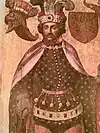 |
Before 1205 | 1225–1227 | 8 July 1261 | Schauenburg | Heilwig of Lippe 1223 four children |
Count of Holstein by military victory over Valdemar II; he later resigned and became a monk. |
| 1227–1238 | Schauenburg and Holstein | ||||||
| Regency of Heilwig of Lippe (1238-1243) | Sons of Adolph IV, ruled jointly on their first years of rule, under regency of their mother. In 1261, they divided their possessions: John received Holstein-Kiel; Gerhard received Holstein-Itzehoe and also the county of Schauenburg. After Gerhard's death in 1290 his sons partitioned Holstein-Itzehoe and Schaumburg into three branches, with Adolph getting Holstein-Pinneberg and Schaumburg, Gerhard getting Holstein-Plön, and Henry getting Holstein-Rendsburg. | ||||||
| John I | _02.jpg.webp) |
1229 | 1238–1261 | 20 April 1263 | Schauenburg and Holstein | Elisabeth of Saxe-Wittenberg 1249 or 1250 four children | |
| 1261–1263 | Holstein-Kiel | ||||||
| Gerhard I | _01.jpg.webp) |
1232 | 1238–1261 | 21 December 1290 | Schauenburg and Holstein | Elizabeth of Mecklenburg 1250 eleven children Alexia of Montferrat 1282 no children | |
| 1261–1290 | Holstein-Itzehoe (with Schauenburg) | ||||||
| John II the One-Eyed | _01.jpg.webp) | 1253 | 1263–1316 | 1321 | Holstein-Kiel | Margareta of Denmark 1276 two children |
Sons of John I, ruled jointly. In 1273 divided the land: John II kept Holstein-Kiel; Adolph received Holstein-Segeberg. After the death of Adolph in 1308 without descendants, Holstein-Segeberg returned to Holstein-Kiel. In 1316, John II was deposed by his cousin John III from Holstein-Plön. |
| Adolph V the Pomeranian | _02.jpg.webp) |
1252 | 1263–1273 | 10 April or 11 November 1308 | Holstein-Kiel | Euphemia of Pomerania-Wolgast 1273 or 1278 one child | |
| 1273–1308 | Holstein-Segeberg | ||||||
| Gerhard II the Blind | _01.jpg.webp) | 1254 | 1290–1312 | 28 October 1312 | Holstein-Plön | Ingeborg of Sweden 12 December 1275 four children Agnes of Brandenburg 1293 one child |
Children of Gerhard I, divided the land. Adolph VI received, with his portion at Pinneberg, the original Schauenburg. |
| Adolph VI the Elder | _01.jpg.webp) | 1256 | 1290–1315 | 13 May 1315 | Holstein-Pinneberg (with Schauenburg) | Helen of Saxe-Lauenburg 14 February 1294 seven children | |
| Henry I | _01.jpg.webp) | 1258 | 1290–1304 | 5 August 1304 | Holstein-Rendsburg | Heilwig of Bronckhorst 1289 four children | |
| Gerhard III the Great | _02.jpg.webp) | 1292 | 1304–1340 | 1 April 1340 | Holstein-Rendsburg (with Schleswig 1326-1330) | Sophia of Werle 1315 four children | Profited from the minority of the duke of Schleswig to take over the duchy to himself, but handed it over in 1330. |
| Adolph (VII) | 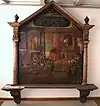 | c.1276 | 1308–1315 | 1315 | Holstein-Segeberg | Luitgard of Mecklenburg 1315 no children | Son of John II, succeeded his uncle Adolph V at Segeberg. Died assassinated and without heirs. |
| Gerhard IV | _01.jpg.webp) | 1254 | 1312–1323 | 1323 | Holstein-Plön | Anastasia of Schwerin 30 July 1313 two children |
Sons of Gerhard II, ruled jointly. In 1316, John III deposed John II of Holstein-Kiel and took over the duchy, leaving sole rule of Plön to his brother Gerhard IV. John III also served, alongside Gerhard III, as lord ruling in guardianship the Danish Duchy of Schleswig 1332–1340. |
| John III the Mild | _02.jpg.webp) |
1297 | 1312–1316 | 27 September 1359 | Holstein-Plön | Catherine of Głogów 25 December 1317 or 27 January 1319 three children Miroslawa of Schwerin-Wittenburg 1327 three children | |
| 1316–1359 | Holstein-Kiel | ||||||
| Adolph VII | 1295 or 1297 | 1315–1354 | 9 October 1354 | Holstein-Pinneberg (with Schauenburg) | Hedwig of Schwalenberg by 1301 three children Helwig of Lippe 1322 eight children | ||
| Gerhard V | _01.jpg.webp) | 1315 | 1323–1350 | 22 September 1350 | Holstein-Plön | Unmarried | After his death, his uncle John III, ruler of -Kiel and previous co-ruler in -Plön, reunites both lands. |
| Nicholas I | _01.jpg.webp) | 1321 | 1340–1397 | 8 May 1397 | Holstein-Rendsburg (with Schleswig 1375-1386) | Elisabeth of Brunswick-Lüneburg 1354 one child |
Nicholas and Henry ruled jointly as sons of Gerhard III. In 1375 they inherited the Duchy of Schleswig from the House of Estridsen. In 1384, with the death of his brother, Nicholas associated his nephews (Gerhard and Albert, sons of Henry) to power. In 1386 he abdicated of Schleswig to his older nephew Gerhard, who assumed alone this lands. In 1390 Nicholas inherited Holstein-Kiel. After Nicholas' death in 1397, the co-ruling nephews, Gerhard and Albert, divided the land. |
| Henry II of Iron | _01.jpg.webp) | 1317 | 1340–1384 1375–1384 | 1384 | Holstein-Rendsburg (with Schleswig 1375-1386) | Matilda of Lippe one child Ingeborg of Mecklenburg-Schwerin before 1374 four children | |
| Adolph VIII the Younger | _01.jpg.webp) | After 1301 | 1354–1370 | 13 October 1370 | Holstein-Pinneberg (with Schauenburg) | Unmarried | |
| Adolph IX the Mild | _04.jpg.webp) | 1327 | 1359–1390 | 26 January 1390 | Holstein-Kiel | Anne of Mecklenburg-Schwerin 4 December 1362 or 21 September 1365 no children | Received from inheritance of his father -Kiel and also -Plön, incorporated in 1350. After his death in 1390 without descendants, -Kiel and its patrimony is inherited by Holstein-Rendsburg. |
| Otto I | %252C_01.jpg.webp) | 1330 | 1370–1404 | After 16 March 1404 | Holstein-Pinneberg (with Schauenburg) | Mechtild of Brunswick-Lüneburg 25 June 1368 ten children | |
| Gerhard VI | 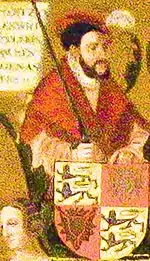 | 1367 | 1386/97–1404 | 5 August 1404 | Holstein-Rendsburg (in Schleswig since 1386) | Catherine Elisabeth of Brunswick-Lüneburg 1390 six children |
Co-rulers in Rendsburg with their uncle Nicholas since 1384. After the abdication of Nicholas in Schleswig, Gerhard took over the duchy, and assumed Rendsburg only after the former's death. Gerhard's brother Albert revived in 1397 the duchy of Segeberg, making official the new division, but after his death in 1403, Segeberg merged again in Rendsburg, still in hands of Gerhard, who died in the following year. |
| Albert II | _01.jpg.webp) | 1369 | 1397–1403 | 28 September 1403 | Holstein-Segeberg | Agnes of Saxe-Lauenburg before 23 March 1399 no children | |
| Henry III | 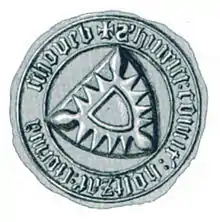 | c.1372 | 1404–1421 | February 1421 | Holstein-Rendsburg | Unmarried | Also Prince-Bishop of Osnabrück as Henry I (1402–1410), and regent in Schleswig. |
| Adolph X | 1375 | 1404–1426 | 9 October 1426 | Holstein-Pinneberg (with Schauenburg) | Helena of Hoya 1378 three children | ||
| Regencies of Catherine Elisabeth of Brunswick-Lüneburg and Henry III, Count of Holstein-Rendsburg and Prince-Bishop of Osnabrück (1404–1413), in Schleswig | Died without descendants. Passed the land to his brothers. | ||||||
| Henry IV | 1397 | 1404/21–1427 | 28 May 1427 | Holstein-Rendsburg (in Schleswig since 1404) | Unmarried | ||
| Otto II | _01.jpg.webp) | 1400 | 1426–1464 | 2 June 1464 | Holstein-Pinneberg (with Schauenburg) | Elisabeth of Hohnstein 1418 ten children | |
| Adolph XI |  | 1401 | 1427–1459 | 4 December 1459 | Holstein-Rendsburg (with Schlewig) | Matilda before 1433 no children Margareta of Mansfeld 1433 no children |
Sons of Gerhard VI, ruled jointly in Holstein-Rendsburg. As Gerhard also wanted to rule in Schleswig he claimed (unsuccessfully) this duchy for himself against his brother. Adolph was the mightiest vassal of Danish crown at his time, gaining royal Danish recognition in 1440. After Adolph's death his patrimony is annexed by Denmark. |
| Gerhard VII | _01.jpg.webp) | 1404 | 1427–1433 | 24 July 1433 | Holstein-Rendsburg (with Schlewig) | Agnes of Baden 2 June 1432 Baden ten children | |
| Adolph XII | 1419 | 1464–1474 | 9 October 1474 | Holstein-Pinneberg (with Schauenburg) | Irmgard of Hoya 1459 no children | First son of Otto II. Left no descendants. | |
| Eric I | 1420 | 1474–1492 | 24 or 25 March 1492 | Holstein-Pinneberg (with Schauenburg) | Heba of East Frisia 1476 no children | Second son of Otto II. Left no descendants. | |
| Otto III | _01.jpg.webp) | 1426 | 1492–1510 | 1510 | Holstein-Pinneberg (with Schauenburg) | Unmarried | Third son of Otto II. Left no descendants. |
| Anton I | 1439 | 1510–1526 | 22 December 1526 | Holstein-Pinneberg (with Schauenburg) | Sophia of Saxe-Lauenburg 29 November 1492 no children Anna of Schönburg before 25 September 1497 no children | Sixth son of Otto II and the fourth ruling. Left no descendants. | |
| John IV | 1449 | 1526–1527 | 30 March 1527 | Holstein-Pinneberg (with Schauenburg) | Cordula of Gehmen 1482 one child | ||
| Jobst I | 1483 | 1527–1531 | 5 June 1531 | Holstein-Pinneberg (with Schauenburg) | Maria of Nassau-Dietz 1506 eight children | ||
| Adolph XIII | _von_Schaumburg_01.jpg.webp) | 19 January 1511 | 1531–1544 | 20 September 1556 | Holstein-Pinneberg (with Schauenburg) | Unmarried | Joint rule with his brother John IV. Abdicated in 1544. Later he became Archbishop of Cologne as Adolph III (1547–1556). |
| John V | 1512 | 1531–1544 | 1560 | Holstein-Pinneberg (with Schauenburg) | Elisabeth of East Frisia 1558 no children | Joint rule with his brother Adolphus XIII. Abdicated in 1544. | |
| Otto IV |  | 1517 | 1544–1576 | 21 December 1576 | Holstein-Pinneberg (with Schauenburg) | Maria of Pomerania-Stettin before 1545 four children Ursula of Brunswick-Lüneburg 1558 three children | In 1559 he officially began the Reformation in Schauenburg and Holstein-Pinneberg. |
| Adolph XIV | _(Schaumburg)_01.jpg.webp) | 27 February 1547 | 1576–1601 | 2 July 1601 | Holstein-Pinneberg (with Schauenburg) | Elisabeth of Brunswick-Wolfenbüttel 6 May 1583 Wolfenbüttel one child | |
| Ernest | 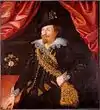 | 24 September 1569 | 1601–1622 | 17 January 1622 | Holstein-Pinneberg (with Schauenburg) | Hedwig of Hesse-Kassel 11 September 1597 Schmalkalden ten children | Brother of Adolphus XIV. Was elevated to "Prince of Schaumburg" in 1619. |
| Jobst Herman | 6 October 1593 | 1622–1635 | 5 November 1635 | Holstein-Pinneberg (with Schauenburg) | Catherine Sophia of Brunswick-Harburg (1577-1665) no children | Cousin of his predecessor. Died without descendants. | |
| Otto V | 1 March 1614 | 1635–1640 | 15 November 1640 | Holstein-Pinneberg (with Schauenburg) | Unmarried | Cousin of his predecessor. Died without descendants. | |
External links
- Marek, Miroslav. "List of rulers of Holstein". Genealogy EU.
- Marek, Miroslav. "Genealogy of Schauenburg". Genealogy EU.
- (in German) Dukes of Schleswig-Holstein
Notes
- Lemma Schauenburg/Schaumburg. In: Klaus-Joachim Lorenzen-Schmidt, Ortwin Pelc (Hrsg.): Schleswig-Holstein Lexikon. 2. Aufl., Wachholtz, Neumünster, 2006.
- The numbering varies; some authors count all namesakes within the House of Schauenburg, here put in front, others count only the namesakes within any branch line, here given in parentheses.